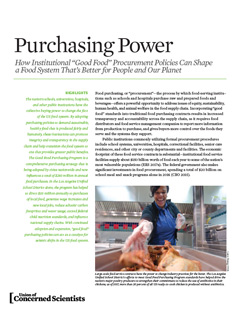The US food system is failing us on many fronts. Too many people lack reliable access to affordable, healthy food. Food system workers are routinely exploited. Farm animals are mistreated in ways that harm their health—and ours. Midsize family farms are disappearing from our rural communities, taking jobs and economic growth with them. Industrial agriculture pollutes our water, degrades our soil, and accelerates climate change. And people of color bear an unjust share of all these burdens.
The good news is that solutions are out there. Community and labor leaders, farmers, and scientists have identified ways to build a system capable of producing "good food" that's healthy, environmentally sustainable, fair to workers, and affordable for all of us. But the people who benefit most from the prevailing system—large agribusiness companies and their lobbyists and trade groups—wield outsized influence over the policies that shape it.

Harnessing the power of institutional purchasing
In this uphill battle, good food advocates have discovered a secret weapon: institutional food buyers. Large public institutions like schools, hospitals, and prisons supply about $120 billion worth of food each year, often serving some of the nation's most vulnerable populations. When these institutions set progressive standards for food procurement—for instance, requiring their suppliers to treat workers fairly, observe nutritional guidelines, and source food whenever possible from local farmers—they give a boost to the good food movement that can reverberate far beyond the populations they serve directly.

Making good food work in Los Angeles
Our 2017 report, Purchasing Power, looks at the example of Los Angeles, where a number of city departments and agencies, including the Los Angeles Unified School District (LAUSD), have implemented a model called the Good Food Purchasing Program (GFPP) over the past five years. The report shows how LAUSD’s adoption of GFPP has brought multiple benefits to Los Angeles and the surrounding areas:
Local economy and labor impacts. Labor organizations such as the Teamsters union and the Food Chain Workers Alliance have used LAUSD's policy to organize food system workers, such as the drivers at food distributor Gold Star Foods. GFPP has helped workers win wage increases and better working conditions. Local food purchases under GFPP have also helped drive job creation—and the report found that further increases in local food buying would amplify this effect.
Environmental sustainability improvements. While California is a leader in sustainable farming by some measures, agriculture in the state continues to pose environmental threats, including heat-trapping emissions, groundwater contamination, and depletion of natural resources. LAUSD has taken steps under GFPP to reduce its environmental impact, such as sourcing more food from certified sustainable producers and changing school menus to lower carbon footprints and water use. Reductions in meat purchases, for example, have lowered LAUSD's carbon footprint by an estimated 22 percent.
Health and nutrition gains. LAUSD operates the largest school breakfast program and second largest school lunch program in the US. Many of the students it serves experience food insecurity, which makes the quality of their school meals especially important. By following GFPP standards that exceed national school lunch requirements, the district has made changes that will mean longer and healthier lives for the children it serves. For example, LAUSD cafeterias have committed to serving less sodium and processed meat, and more health-promoting whole grains—dietary changes that can help reduce the risk of diet-related diseases like hypertension, colorectal cancer, and type 2 diabetes.
Animal welfare improvements. The routine use of antibiotics on healthy animals in livestock production compromises animal well-being and increases the risk of antibiotic resistance, which makes human infections more challenging to treat. Good food advocates and consumer groups have been working to make antibiotic-free meat more available and affordable. By including requirements for antibiotic-free chicken in its contract proposals, LAUSD has helped to accelerate progress on this front: between 2015 and 2017, the share of antibiotic-free chicken produced by three of the nation's five largest poultry producers quadrupled.
Magnifying GFPP's impact
A current campaign to expand GFPP to include all of Los Angeles County could amplify its benefits, the report found. A few highlights:
- Expanding GFPP adoption to LA County schools could more than double the benefits to the local economy and the number of jobs created—and increasing the share of food sourced from local suppliers would magnify these benefits further.
- If all LA County schools adopted GFPP and implemented meat reduction strategies like LAUSD's, the reduction in carbon footprint would be equivalent to taking 7,240 cars off the road each year.
- Moving forward with school lunch sodium targets under GFPP could help reduce blood pressure for an estimated 370,000 students across the LA County school system, and could protect students against cardiovascular risk factors into adulthood.




